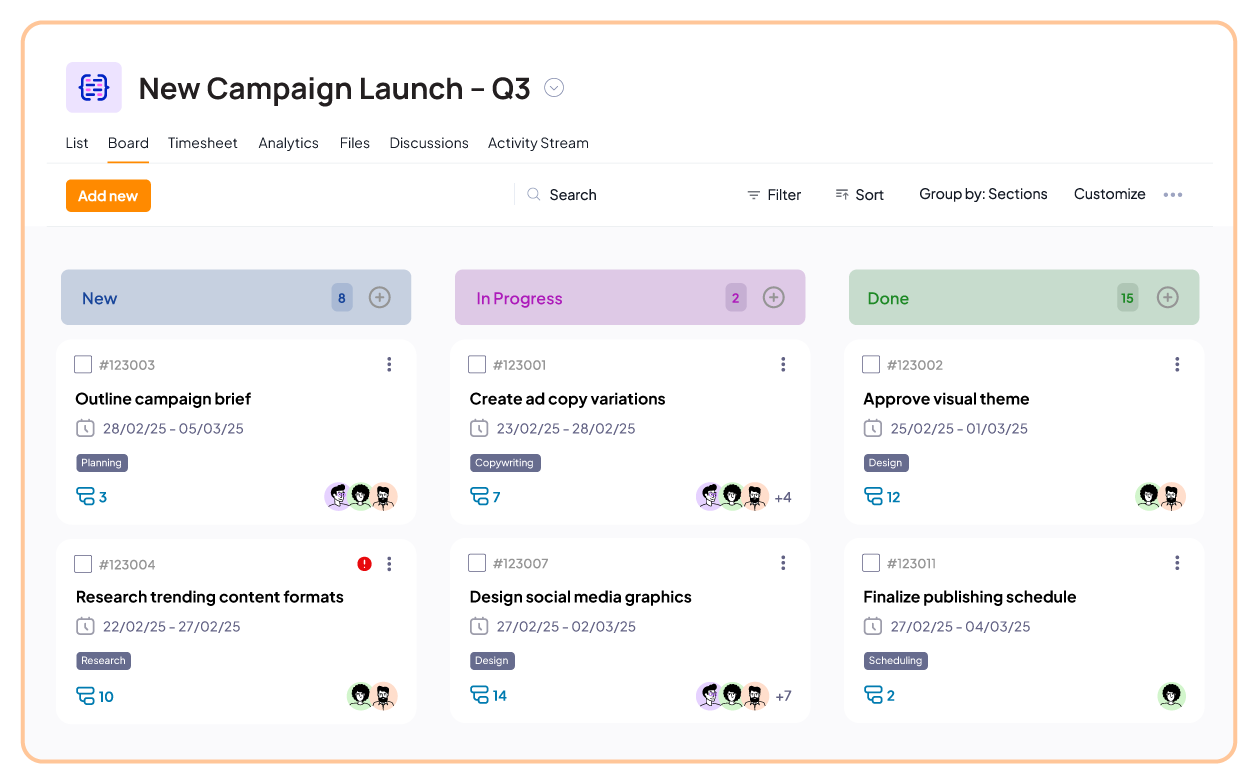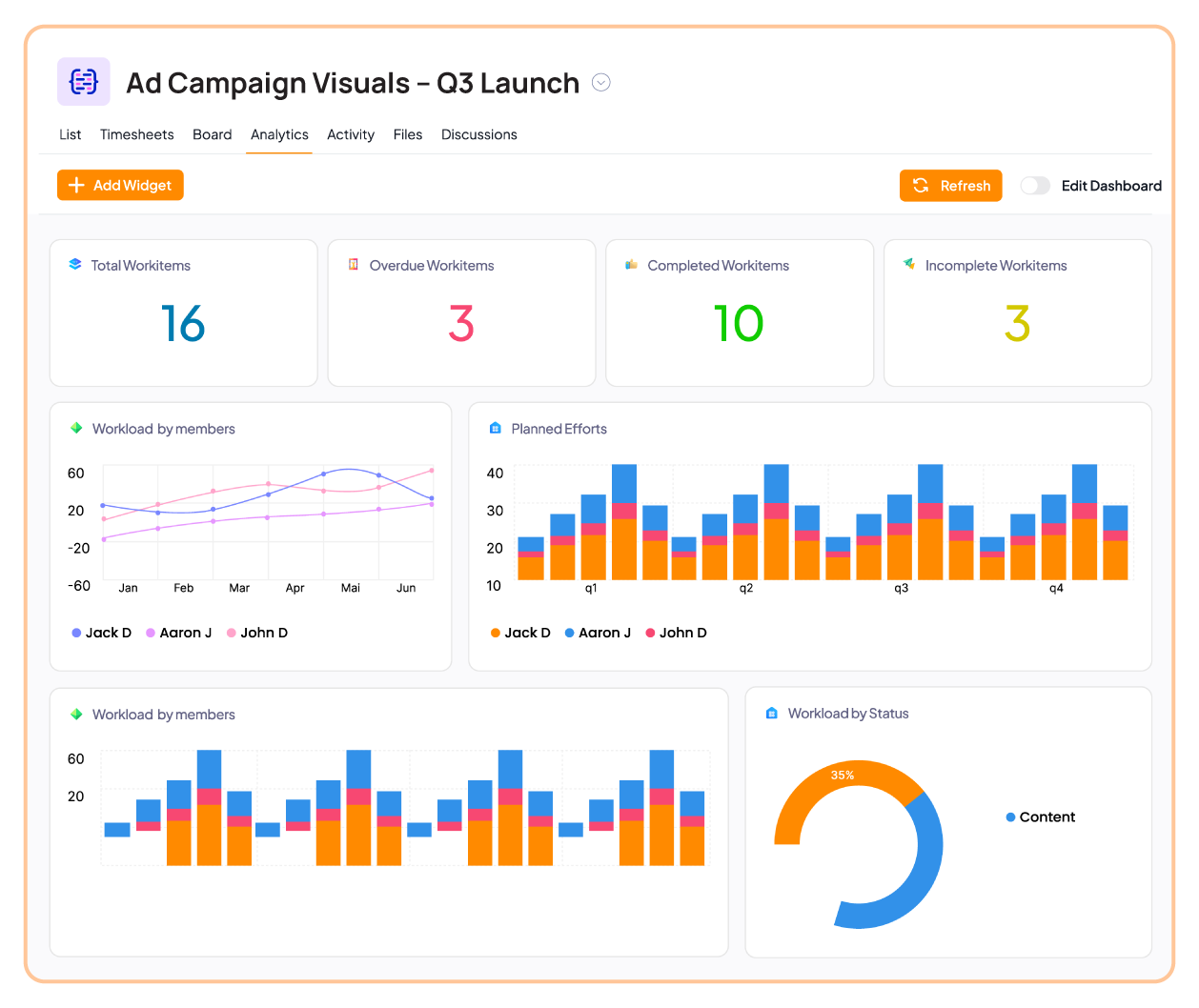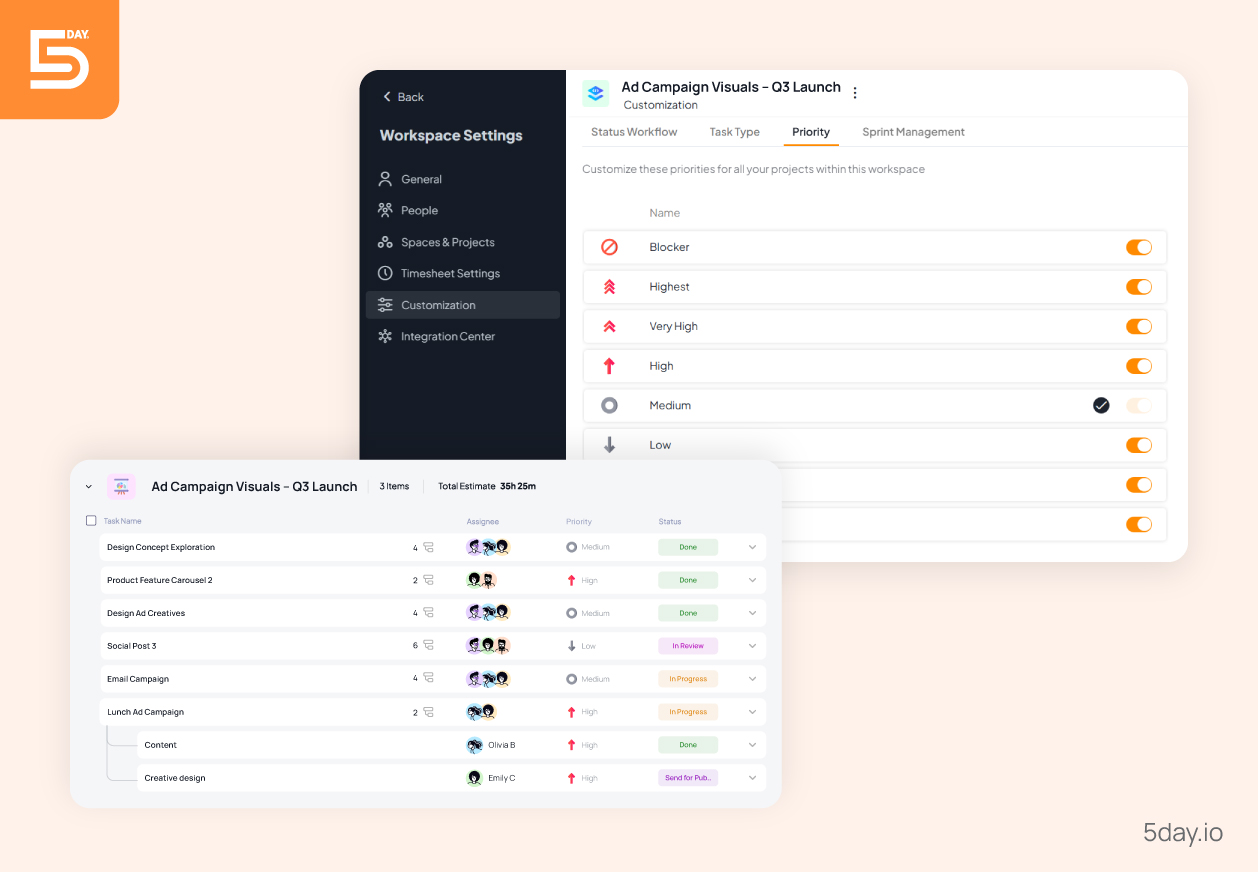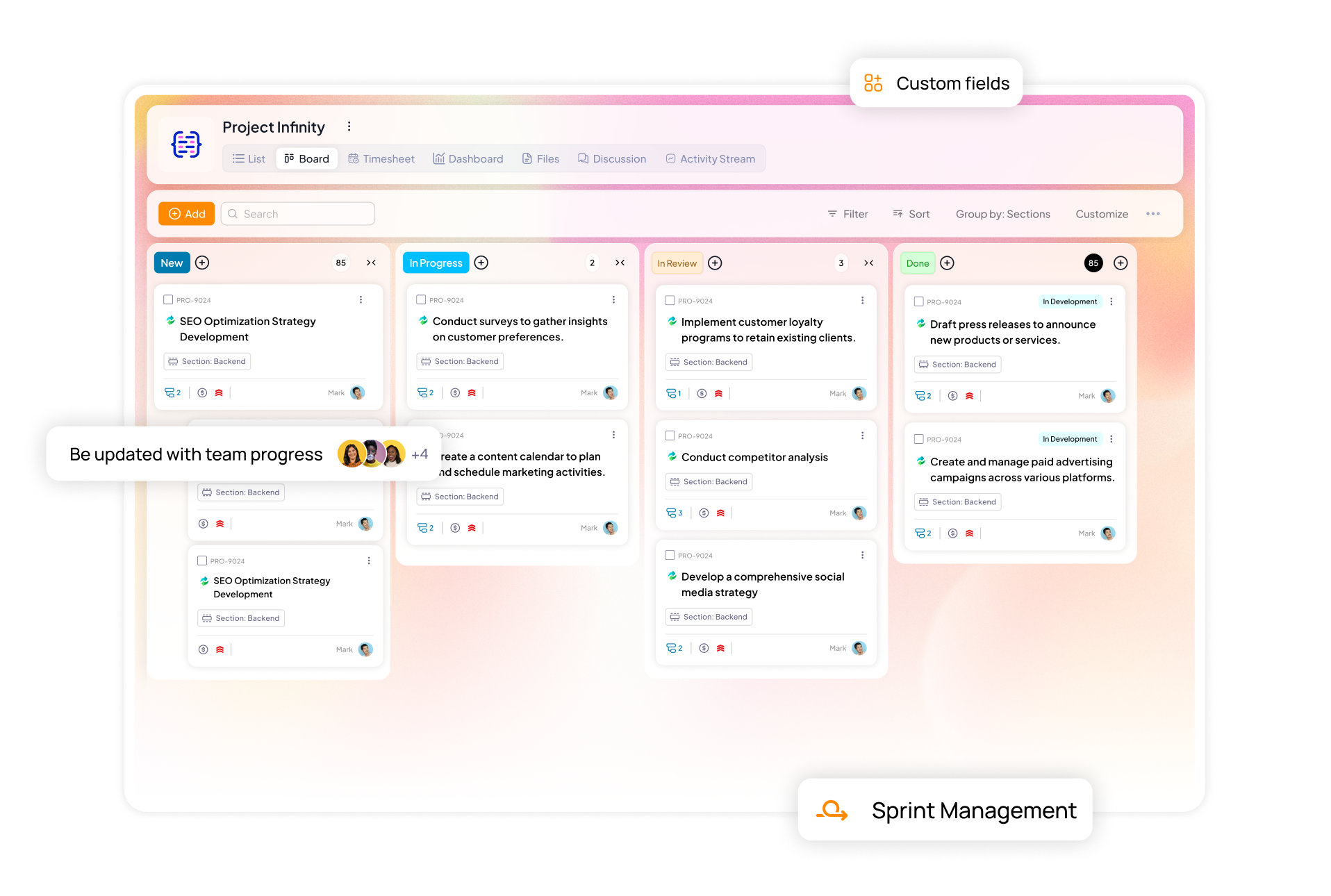You just hit send on your quarterly newsletter, then notice the links are missing and the banner image is wrong.
Welcome to the world of marketing, where one simple task slip can spark a week of rework.
Businesswire reveals that many professionals spend roughly 10 hours a week on unproductive tasks. That’s valuable time lost to manual tracking. Time your team could use to do their best work.
That’s exactly why having the right systems and task management strategies for marketing teams matters.
In this article, you’ll learn how to avoid common task overload problems. More importantly, you’ll find practical task management strategies to keep your campaigns on track.
Common challenges of task management in marketing teams
Too many tasks with unclear priorities and visibility can leave teams stressed.
Marketing teams often juggle multiple campaigns (email, social, ads, PR, etc.) at once. As a result, tasks can pile up fast with less time to address them. Without clear priorities, urgent tasks can bury important ones.
Most common challenges marketing teams face include:
-
Scope creep and shifting priorities
New requests and last-minute ideas can quickly stretch a project beyond what the team originally planned. Without a clear scope, tasks pile up fast, and so does confusion.
What starts as a simple email campaign suddenly includes a landing page, four social posts, and a webinar, all with the urgent deadlines.
When no one adjusts the plan or reallocates resources, task lists spiral and deadlines start slipping. That’s why defining scope early and sticking to it saves time and rework later.
-
Struggle with fragmented workflows
Most marketing teams rely on a mix of tools to get things done. Writers draft in Google Docs, planners update spreadsheets and feedback flows through email or chat. At first, it works, but over time, switching between platforms wastes time.
Without a shared workspace, team members waste valuable time playing detective, digging through old threads or multiple file versions. Instead of moving work forward, they chase context. That fragmentation slows everything down, especially when deadlines are tight.
-
Manual tracking and errors
A popular approach is to track tasks in spreadsheets. But it leads to tedious workflows and error-prone files. Marketing project managers still spend around 10 hours each week updating rows, fixing formulas, or chasing task status.
Each extra sheet adds more risk. One tracks deadlines and another third logs content status. It only takes one missed cell or wrong copy-paste for something critical to fall through. When the workload’s already heavy, that kind of manual setup turns simple tasks into avoidable chaos.
Also read: 5day.io vs Spreadsheets: A Detailed Breakdown
-
Messy schedules and burnout
When there’s no clear system in place, team members end up doing more work than they can realistically handle. Your designer might be stuck delivering assets for three active campaigns.
At the same time, your content lead could be writing ad copy, blog posts, case studies, and social captions without any real adjustment to their bandwidth.
If no one tracks workload or capacity, people overcommit. They log in late and push through weekends just to stay afloat. This leads to pressure buildup that shows up in mistakes and high stress levels across the team.
-
Communication gaps
Marketing projects usually involve multiple stakeholders. Without a shared view of tasks, teams lose track of critical updates. Team members rely on email chains or memory to track approvals and feedback.
Soon enough, people miss a revision request or wait too long for a decision. You spend more time asking, “Did you see this?” than moving work forward. These gaps don’t just slow you down. Instead, they turn into last-minute fire drills that derail progress.
Key elements of successful task management
Clear goals, priorities, and accountability form the foundation of effective task management. When you set expectations early, you reduce confusion later.
So, before diving straight into effective task management strategies, make sure your team consider the following fundamental elements.
-
Define your scope and tasks
Start by mapping out exactly what the project includes. Break the campaign into specific, manageable tasks and deliverables. Creating a Work Breakdown Structure (WBS) or even a simple task checklist helps everyone stay aligned on what needs to happen.
For example, a product launch might include research, creative briefs, asset design, content writing, and distribution planning. When you list tasks clearly, you make it easier to assign ownership and track progress.
-
Assign clear ownership and accountability
Every task needs a name next to it. People often miss tasks and duplicate efforts when ownership is vague. Assign each task to a specific team member, or a small group if needed, and include a due date.
That way, everyone knows who’s responsible and when it’s due. If someone needs to follow up or escalate a delay, there’s no guessing. Clear accountability keeps the entire team moving in sync.
-
Use a consistent prioritization method
Not all tasks carry equal weight, so you need a way to sort them. Choose a prioritization method that fits your workflow. For example:
- The Eisenhower Matrix helps you separate urgent tasks from important ones
- The MoSCoW method ranks items by must, should, could, and won’t do
- The 5 Ds of Task Management (dissect, do, delegate, defer, delete) let you break things down and act quickly
Using these methods helps your team stay focused on real work and not get stuck in busywork.
-
Set realistic timelines and milestones
Deadlines should work for your team and not against them. Once you list out all tasks, assign reasonable due dates and group them into project milestones and phases.
If a task feels too broad, like “develop brand strategy,” break it down. Add subtasks like competitor analysis and brand positioning, then pin clear dates to each one. This approach helps teams track progress and spot delays before they escalate.
-
Make progress visible

When people can see progress, they stay motivated and aligned. Use tools that give everyone visibility into the work. Whether it’s a list view, Kanban board, calendar, or timeline, choose a layout that suits your team’s style.
For example, a Kanban board shows tasks moving from “to do” to “in review” to “done.” The right view gives managers a quick snapshot of what’s on track and what’s falling behind.
-
Build open communication processes
Approvals shouldn’t slow you down or go missing in someone’s inbox. Define how your team handles feedback and reviews.
For creative tasks, establish clear stages like:

Then assign a reviewer at each step. Tag the reviewer in your task system so they get notified right away. Keep files locked to the latest version. When you build feedback loops into your workflow, you reduce confusion and prevent duplicated effort.
-
Regular updates
Have brief check-in meetings or updates (daily stand-ups or weekly reviews) where the team reviews key tasks and roadblocks. Use these touchpoints to review progress, flag blockers, reassign work, and celebrate wins.
Regular check-ins help you catch issues early and keep the momentum going even when priorities shift mid-project.
The best task management strategies for marketing teams
Now that you know the fundamentals, it’s time to put them into action. Let’s explore how to improve task management for marketing teams that reduces last minute confusion.
Better task management starts with structure and sticks with small, smart habits. When you create clarity around what to do and when it needs to happen, your campaigns move fast.
The following best task management strategies for marketing teams can make day-to-day marketing work more efficiently:
-
Break down projects into manageable tasks
Start by splitting large projects into smaller, trackable pieces. Use a WBS or task hierarchy to map it out. Smaller tasks feel less overwhelming, and they’re easier to estimate and track. Once you have the list, use a prioritization method.
-
Prioritize effectively
Decide what to tackle first using a prioritization method that works for your team. The Eisenhower Matrix helps you identify what’s urgent and important. Knock out those tasks first. The 5 Ds framework goes even further by helping you eliminate unnecessary work.
For example, if a client’s email is due tomorrow, move it to the top. But if it’s about updating internal documentation, you might defer or delegate it. These methods for prioritizing tasks keep your team focused on high-impact work instead of getting lost in everything.
-
Use templates and checklists
Most marketing workflows follow similar steps, like briefs, drafts, reviews, and launch. Instead of starting from scratch each time, build templates for your most common projects. Whether it’s a product launch or event promo, a repeatable task list helps you stay consistent.
Layer checklists into those templates to make sure nothing slips. A simple pre-publish checklist, for example, can prevent missed links or outdated graphics from going live.
-
Batch and sequence tasks
Group similar work together and tackle it in focused blocks. For instance, write all your ad headlines in one session before jumping into image edits. This cuts down context switching and helps people get into a focused flow.
Also, line up dependent tasks in the right order. Don’t start designing if the copy isn’t final. Use your task board to visualize the sequence and keep things moving smoothly from stage to stage.
-
Delegate and collaborate
Not every task needs your input, and that’s a good thing. Lean on your team’s strengths. If your designer can create landing page graphics or your copywriter can handle email flows, let them own those pieces.
Use your task system to assign co-owners where collaboration is needed. Tag teammates in comments or kick off a quick thread to clarify who’s doing what. The earlier you align, the faster things move.
-
Set up automated reminders
Missed deadlines usually stem from forgotten tasks and not bad intentions. Set up reminders to catch things before someone misses them. A simple alert one day before a due date can save hours of last-minute scrambling.
A reliable task management tool like 5day.io allows you to automate these nudges so you never have to chase status updates again.
-
Use visual boards or calendars
Don’t rely solely on lists. Add visual context by using Kanban boards, calendars, or timelines. When your team sees work in motion, it’s easier to spot bottlenecks or overdue items.
For example, a timeline view can map out your entire project from start to finish, showing dependencies between tasks and highlighting any delays. A calendar view highlights overlapping deadlines. These views give everyone, especially project managers, a quick sense of where things stand.
-
Use quick daily or weekly touchpoints
A 10-minute daily stand-up or a weekly sync can solve problems before they grow. Ask each team member three things:
- What did you finish?
- What’s next?
- And what’s blocking the team’s time?
These touchpoints help your team stay in sync and allow you to reprioritize when last-minute client requests show up.
-
Create a lightweight approval workflow
Approvals often slow teams down, but they don’t have to. Define who needs to sign off and set clear expectations. For example, if no one provides feedback within 24 hours, move the task forward.
Use your task platform to assign reviewers and keep files attached to tasks. This keeps feedback loops short and prevents version confusion.
-
Balance workload proactively
Too much work on one plate slows everything down. Check team bandwidth regularly and rebalance when needed. For smoother capacity planning, block off 20% of each person’s time for last-minute asks or urgent changes.
Redistributing tasks early prevents burnout later. And it ensures no one quietly drowns while the campaign clock ticks on.
-
Time-box and use focus techniques
Some tasks need heads-down time. For writing or design work, use time-blocking to carve out uninterrupted focus. The Pomodoro Technique (25 minutes of work followed by a 5-minute break) helps people stay sharp without burning out.
Encourage team members to time-box their high-priority work. It creates space for deep thinking, not just reactive task handling.
The role of marketing team project management software in managing tasks
A central platform transforms how marketing teams manage work. Instead of jumping between emails and spreadsheets, a dedicated project management tool brings all your moving parts into one place.
It turns the daily chaos into structure, giving your team a shared source of truth.
Here’s how project management in marketing becomes smarter, faster, and more collaborative with the right tool in place.
-
Keeps task tracking unified and real-time
Spreadsheets scatter data. A proper project management tool brings every task into one space where the whole team can see what’s going on. The moment someone updates a task or marks it complete, everyone sees the change.
Dashboards and multiple views, like lists, Kanban boards, and list views, let you monitor progress and plan upcoming work. These features help organize work and create the backbone of effective task management techniques that keep your campaigns on track.
-
Helps assign ownership and drive accountability
In a spreadsheet, you might write someone’s name in a cell. But it won’t hold them accountable. A project management platform lets you assign tasks directly and set clear deadlines.
That clarity makes a difference. Defined task ownership creates momentum and accountability without micromanagement. When your team knows who owns what, you avoid delays, eliminate confusion, and move work forward with fewer check-ins.
This is one of the most overlooked yet powerful task management tips that make responsibility visible.
-
Collaboration and files in context
Marketing work always includesrevisions and feedback loops. Without a shared workspace, teams waste time digging through inboxes or hunting for the latest version of a file.
With tools like 5day.io, you can attach creative briefs, images, spreadsheets, and comments directly to the task. Conversations and files stay right where the work happens. That’s how you improve marketing team collaboration, not by adding more tools, but by connecting the right ones in the right context.
-
Use automations to reduce busywork
Repetitive actions slow down teams and eat into creative hours. A good project tool helps you eliminate that drag. For instance, you can set recurring tasks, automate status changes, and trigger alerts based on updates.
This approach saves hours of manual follow-ups and lets your team focus on creative output. Automating routine steps through templates is one of the simplest but most impactful task management methods you can adopt.
-
Integrations
Marketing teams already use plenty of tools. A solid project management system connects with the ones you rely on every day, like Google Drive, OneDrive, or your CRM.
When tasks and files flow automatically between platforms, you reduce copy-paste errors and save time. These integrations support smoother workflows and let you improve marketing team collaboration without frequent tool-switching.
-
Reduce errors and stay consistent
Manual tracking always carries risk. A single missed update or wrong formula can throw off an entire campaign. The best task management software solves that by using structured fields with dropdown statuses and priority labels.
With less manual entry and built-in consistency checks, your team catches problems early.
-
Gain real insights and reports

Spending time on reporting pulls teams away from the work that matters. But without insights, it’s hard to know where things stand. That’s where reporting dashboards come in.
With 5day.io project management software, you can generate instant reports. It can show overdue tasks, time spent per campaign, team assignees, and more. These visual summaries give marketing leaders the clarity to reallocate resources and address blockers.
In short, when everything is on one platform, collaboration naturally improves. It means teams spend less time chasing tasks and more time executing campaigns.
How 5day.io helps with task management strategies for marketing teams

Effective marketing task management strategies transform campaign chaos into coordinated work. When you break down work, set clear priorities, and track progress visually, your team works smarter, and not harder.
That’s exactly where 5day.io comes in.
- The platform brings all your tasks and files into one place, so nothing gets lost in spreadsheets or chat threads
- You can assign tasks, set priorities, and attach feedback, all in context
- Built-in views like Kanban boards and list views help you spot blockers early and keep deadlines realistic
- With built-in timesheets, team members can log how much time each campaign takes and plan better next time
And because the interface stays clean and intuitive, your team can get started fast. It doesn’t require a steep learning curve and reduces unnecessary complexity.
If you’re ready to simplify marketing task management and focus on real work, give 5day.io a try. Start free for 30 days (no credit card needed).






